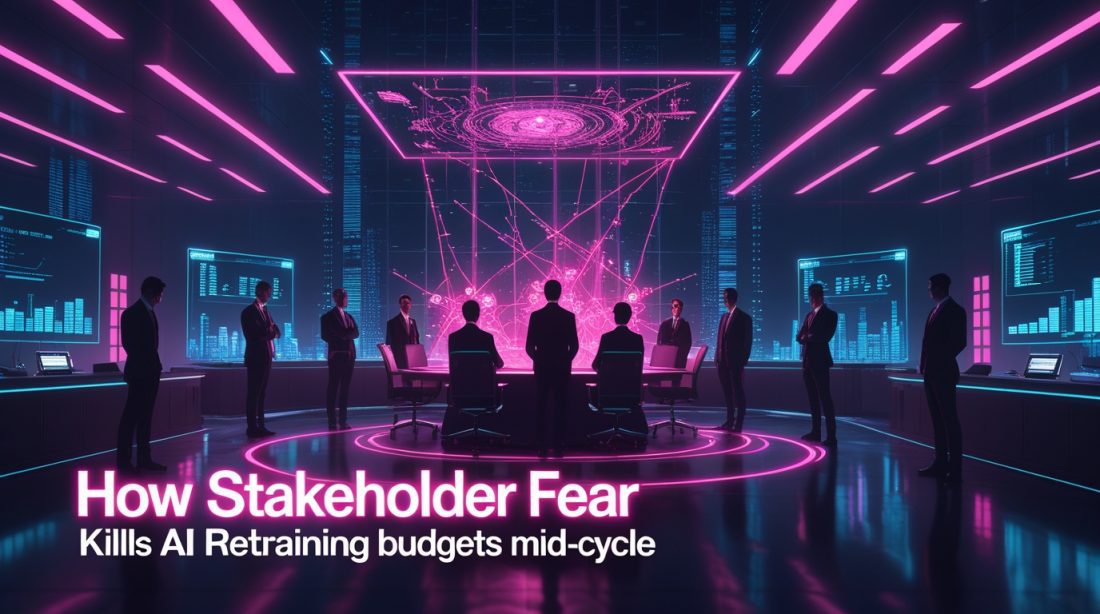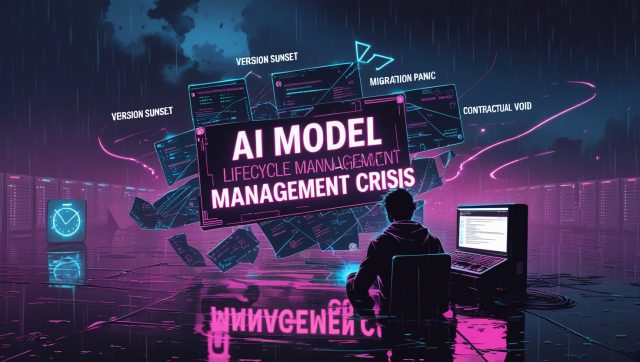The success of your company’s AI transformation hinges less on the models you choose and more on the people you empower.
A mid-level manager at a large manufacturing firm—let’s call him David—watched his company’s ambitious AI initiative unravel in real-time. After a promising pilot phase, the project required a crucial mid-cycle budget approval for employee retraining.
The funding was denied. The reason? A key stakeholder, fearing the project’s rising costs and unclear immediate returns, decided to “wait and see.”
How Stakeholder Fear Kills AI Retraining Budgets Mid-Cycle
— this phrase captures the core of what happened. The story is fictional, but the pattern is not. Across industries, AI retraining budgets are being slashed mid-cycle, not because the funding doesn’t exist, but because deep-seated stakeholder fear kills them before they can bear fruit.
This article from Industrial AI Analysis explores why this happens and the immense cost of these decisions. For a deeper dive into how industrial AI can boost efficiency and overcome such challenges, check out this analysis on industrial AI strategies for 2025.
The High Stakes of Mid-Cycle Budget Cuts
The push for AI adoption has never been stronger. Research indicates that over 80% of companies are now using or exploring AI. Yet, a sobering MIT study reveals a brutal truth: 95% of corporate AI initiatives deliver zero measurable return.
The common denominator in these failures is rarely the technology itself. Instead, it’s the human and organizational factors, with a lack of skilled employees being a primary bottleneck. When stakeholders get cold feet and pull funding for retraining mid-cycle, they create a self-fulfilling prophecy of failure. The very investment needed to ensure ROI is the first to be cut. To understand how AI-driven solutions can mitigate such risks in manufacturing, explore this guide on predictive maintenance AI for factory efficiency.
Why Stakeholder Fear Derails AI Retraining
1. The “Black Box” Anxiety and Unclear ROI
Why stakeholders get spooked by the “black box” and unclear returns
Many leaders suffer from technology anxiety, particularly around AI. AI systems can be complex “black boxes,” making it difficult to trace how decisions are made. This lack of transparency erodes trust.
When a multi-million dollar AI system is installed, stakeholders expect a clear and rapid financial return. However, retraining employees to work effectively with AI is a medium-to-long-term investment. A Deloitte analysis notes that most organizations need 6 to 12 months to achieve strong ROI from AI, as they must overcome adoption challenges like workforce training. Stakeholders seeing initial cost overruns may panic and cut the “soft” cost of training to protect the bottom line, inadvertently dooming the entire project.
For insights on overcoming AI transparency issues, Gartner’s article on explainable AI highlights why trust in AI systems is critical for adoption.
2. The Silo Effect and Leadership Misalignment
Why disconnected leadership leads to budget cuts
AI integration is not just an IT project; it’s a company-wide transformation. McKinsey’s research concludes that the biggest barrier to scaling AI is not employees, but leaders who are not steering fast enough.
When different departments—IT, HR, Finance, and Operations—are not aligned, fear thrives in the silos. The CFO, worried about rising costs highlighted in a recent CIO.com survey, may veto retraining budgets without a full understanding of their strategic importance. This disconnect creates a cycle of underinvestment in people, leading to poor adoption and reinforcing the stakeholder’s initial fear that the investment was wasted. To see how IT and OT team clashes exacerbate these issues, read this piece on IIoT data ownership conflicts.
3. Short-Term Cost Pressure Versus Long-Term Vision
Why quarterly earnings reports trump long-term transformation
In the tug-of-war between quarterly financial targets and long-term strategic goals, the immediate often wins. AI cost overruns are common, with one survey finding 85% of organizations misestimate AI costs by more than 10%.Faced with these overruns, managers are forced to find savings. Retraining budgets, which may not show a direct financial return for several quarters, become easy targets.
This is a catastrophic error. As one industry expert noted, “Underestimating AI projects by this much doesn’t just blow budgets, it risks stakeholder confidence and adoption.” Cutting training to save money is like stopping half-way through a factory automation upgrade—it renders the initial investment useless. For a broader perspective on AI-driven cost optimization, Harvard Business Review’s report on AI in business transformation offers practical strategies to align short- and long-term goals.
The Domino Effect of Killing a Retraining Budget
Pulling the plug on employee development for AI doesn’t just pause progress; it triggers a chain reaction of negative outcomes:
- Massive Wasted Investment: The millions spent on software licenses, infrastructure, and pilot projects are squandered because the workforce lacks the skills to use the new tools effectively.
- Plummeting Employee Morale: Employees who were told to prepare for the future of work feel abandoned and disillusioned. This fuels AI resistance, as they see the technology as a poorly supported burden, not an aid. Learn more about this issue in this article on AI resentment in industrial workplaces.
- Rise of “Shadow AI”: Desperate to meet their goals, employees turn to unsanctioned, consumer-grade AI tools, creating massive security, compliance, and data privacy risks. For a deeper look at AI-related security risks, check out this analysis on AI cybersecurity threats.
- Irreparable Erosion of Trust: As the MIT study shows, projects with external partners succeed at nearly double the rate of internal builds (about 67% vs 33%). This statistic highlights a crisis of internal confidence. When leadership abandons a high-profile initiative, it shatters employee trust for future transformations.
A Path Forward: Securing Your AI Retraining Budget
Overcoming the fear that kills budgets requires a proactive, strategic approach.
- Communicate with Transparency, Not Just Hype: From day one, frame retraining not as an optional cost, but as the essential core of the AI investment itself. Be brutally honest about the timeline for ROI, building trust through realism.
- Showcase “Quick Wins” and Early Metrics: Identify and promote small, early successes. Did a team use new AI skills to automate a tedious report? Quantify the time saved and share it widely. These tangible proofs of concept build momentum and defend against mid-cycle cuts.
- Co-Create the Retraining Plan with Stakeholders: Involve finance and other leaders in designing the retraining roadmap. When stakeholders have a hand in creating the plan, they become owners, not just critics, and are far more likely to defend it.
- Partner with External Experts: Acknowledge internal skill gaps. Leveraging partnerships with AI vendors or consultants can compress timelines, transfer valuable knowledge, and provide external validation that reassures nervous stakeholders. For example, IBM’s insights on AI workforce transformation emphasize the value of external expertise in scaling AI initiatives.
The greatest risk in today’s AI transformation is not technological failure, but human hesitation. As Marc Benioff, Chair and CEO of Salesforce, aptly described, the goal is a “digital workforce” where humans and automated agents work together. This powerful collaboration cannot happen without investing in the human element.
Stakeholder fear that kills AI retraining budgets mid-cycle is not just a financial decision—it is a strategic failure that guarantees your place among the 95% of projects that deliver nothing. The choice is clear: fund your people and succeed, or fund only your software and fail.
FAQ
Why are retraining budgets often the first to be cut?
Retraining budgets are often perceived as “soft costs” compared to “hard costs” like software licenses or server infrastructure. When stakeholders fear cost overruns, they target these soft costs because the direct impact of cutting them is less immediately visible, even though their long-term importance is critical.
Why is AI reskilling a long-term investment?
Becoming proficient with new AI tools and integrating them into complex workflows doesn’t happen overnight. Deloitte’s analysis suggests it takes most organizations 6-12 months to achieve strong ROI from AI initiatives, as employees need time to learn, experiment, and adapt . This learning curve clashes with the short-term financial expectations of some stakeholders.
Why is clear communication so important for securing AI budgets?
Fear thrives in an information vacuum. When leaders do not transparently communicate the strategy, expected challenges, and realistic timeline for AI initiatives, stakeholders fill the gaps with their own anxieties. Proactive and honest communication builds the trust necessary to weather the inevitable bumps in the road.
What is the #1 reason AI projects fail?
TL;DR
Stakeholder fear is the silent killer of AI transformation, often leading to mid-cycle cuts in essential AI retraining budgets. This happens due to anxiety over AI’s “black box,” leadership misalignment, and pressure for short-term results. Cutting training creates a domino effect: wasted investment, low morale, and project failure. To succeed, companies must communicate retraining as a non-negotiable core investment, showcase quick wins, and involve stakeholders in the plan.
Want to stay ahead in the Industrial AI landscape? Subscribe to our newsletter for weekly, in-depth analyses and proven strategies to navigate the real-world challenges of technological transformation.

